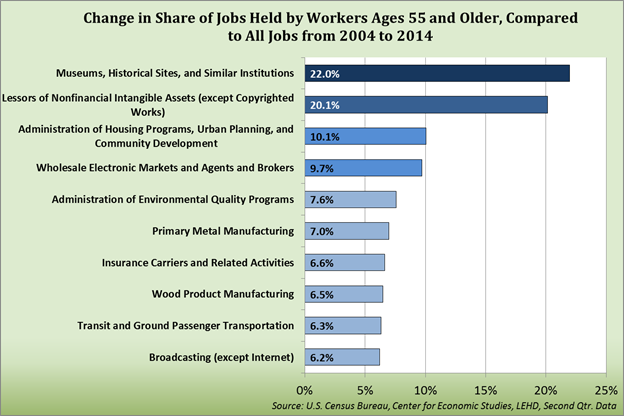 Central Minnesota is a manufacturing stronghold, with several global manufacturing firms operating there.
Central Minnesota is a manufacturing stronghold, with several global manufacturing firms operating there.
The region is especially well known for its expertise in food processing, printing, furniture manufacturing, appliances, machinery and heavy equipment manufacturing.
View our latest blogs on CareerForce. Want the freshest data delivered by email? Subscribe to our regional newsletters.
4/27/2015 10:09:32 AM
Luke Greiner
Every week I read, watch, or hear discussions about the inevitable "Silver Tsunami" - or, the aging of the workforce - that is making its way to Minnesota's economic shore. Various organizations that are fearful of this looming, long-term shortage in our labor supply frequently request data and insight on how the state's shifting demographics will change the labor market.
Employers with great retention and loyal employees will be burdened with a large share of their workers retiring in a short timeframe, and fewer numbers of possible replacements.
Enter the Silver Lining...
During the recession, recent college and high school graduates struggled to find a place in the economy due to the limited number of job opportunities. The tables have turned since that dark period, and business expansions coupled with a wave of retirements are creating an environment ripe with new job opportunities.
Not all industries are experiencing these changes at the same rate, however. A shift-share analysis of age cohorts in the workforce sheds light on which industry subsectors have the most potential for career progression. The chart below illustrates the change in the share of jobs held by workers 55 years and older from 2004 to 2014, over and above the change for all jobs. Because the Silver Tsunami will affect nearly every industry, we can use this analysis to pinpoint what industries should have a higher share of retirements than normal.
Interestingly, the sector with the fastest increase in the share of jobs held by workers ages 55 or older was the museums, historical sites, and similar institutions sector, which increased 22 percent faster than the rate for all jobs in Central Minnesota from 2004 to 2014!
If those workers begin to retire in the near future, there will likely be new job opportunities for current employees in that industry to move up, creating openings at the bottom of the career ladder (unless those jobs are left unfilled). Similarly, all ten industries on the chart should have a higher proportion of job opportunities for both those looking to gain employment and those currently employed looking to progress their careers.
Of course we do not know for certain how many of these workers age 55 and older will retire or when, but common logic and the current returns on retirement investments tell us that a good portion will retire; creating an opening, an opportunity, and a chance for a new generation to take the reins.
Other variables to consider are job openings using DEED's Job Vacancy Survey, as well as long term Employment Outlook Projections.

Contact Luke Greiner at 320-308-5378.